The largest and most impressive karst mountain formations in the world can be admired along the Li River, notably in the stretch that covers the towns of Guilin, Xingping, and Yangshuo. Here is how to see them and the secrets to get the best views.
I spent over two weeks exploring the karst landscapes of the Guangxi Zhuang Autonomous Region as my last place to visit in China, while I was volunteering in a hostel. These stunning, and unreal mountain formations can be seen in many places around the world, but Guangxi is the biggest and most spectacular area of all.
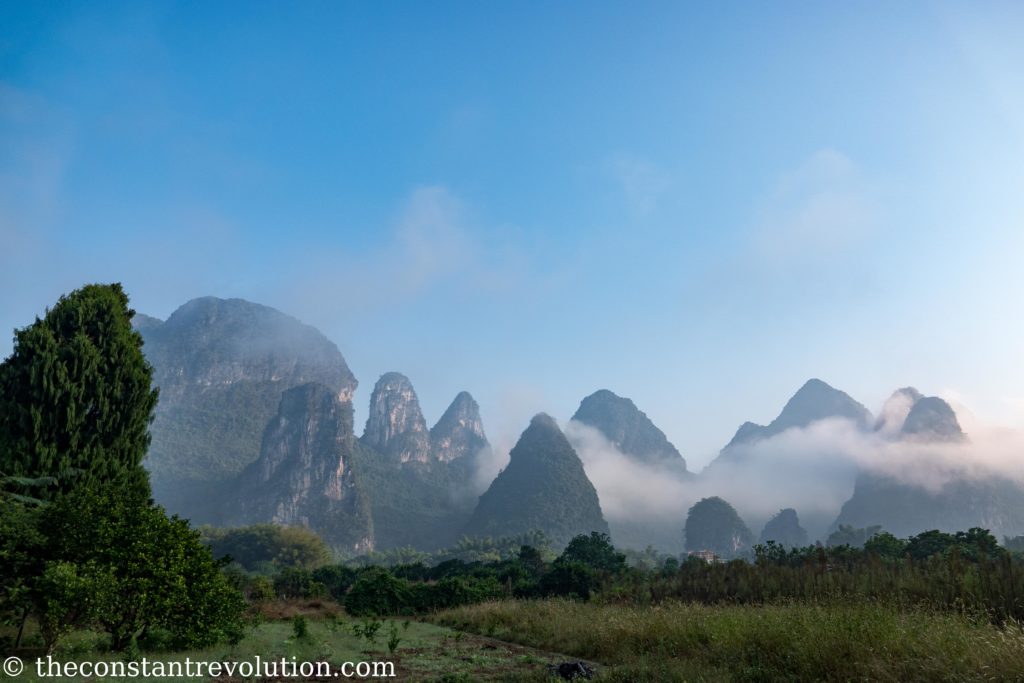
When you trek up to one of the summits, you can see an innumerable number of peaks with the strangest shapes covering the horizon, while the Lijiang River (Li River) insinuates itself among the formations down at the bottom like a snake. That would be a classic view, although even better would be to be up at sunset time, or, my favourite, at sunrise. If you get really lucky, either in the morning or in the evening you could even get to see a mystical karst landscape enveloped in mist. 🙂

They are truly all spectacular views. On the other hand, the province is one of the most touristy areas in China as it is considered one of the country’s natural treasure, perhaps the most famous of all. It’s frequented by hordes of both Chinese and foreign tourists, all looking for a nice pic with the magic landscape as a backdrop.
So, here I’ll explain how to get there, what do do, and most importantly how to find some tranquillity as well 😉
HOW TO GET THERE
The three points of departures to see karst landscapes are normally the two cities of Guilin and Yangshuo, and Xingping village, which lies in between the two. This is also the stretch of the Li River (starting in Guilin) where the formations are to be found.
Guilin is where most of the high-speed trains arrive from other parts of China, and there’s also an airport.
From here you can then move on by train again, or by bus to reach the other two points. The high-speed train is the fastest and it is pretty cheap. For example, it cost 25 Yuan to go from Guilin to Xingping, and it takes about 40 minutes. Buses are slower, about 2h and a half, but allow to enjoy the view.
From Xingping to Yangshuo is just another 20 Km, so it’s pretty fast. There are regular buses connecting the two places every hour or so. It can easily be done also by motorbike or by bicycle. Indeed, the Yangshuo train station is where you get off for Xingping too, and it is closer to the village, only 7 Km, than to the city. All in all, travelling around the area is easy and straightforward.

The only thing to pay attention to is the timetables when you have to move out as in the great majority of cases you’ll have to go back to Guilin to catch a train, a bus or a plane. Sometimes it might be complicated to get there early enough, just get organised in advance, you might have to go and spend the night in Guilin.
HOW TO SEE THE KARST LANDSCAPES
The classic of classics is to take a river cruise, either on one of the bigger one-way boats that cruise along the river in the trait between Guilin to Yangshuo, or in a more traditional bamboo boat, which has up to four seats.
Now, a word of advice, this is what everyone does. Do not believe for a second that you are going to be on your own on the river. There are thousands of boats, big and small, navigating the river in an orderly row all day long like in a procession. Hordes of tourists queue to get on these boats, and to get off them, and to get on those electric cars that take them back and forth to the small ports. And it was low season when I witnessed all of this.
As you probably perceive, I am not a fan of this means to visit the area, to tell the truth after walking around and seeing how it works, I did not do it. But if you are adamant about doing it, it’s going to be pretty easy. There are short and long cruises for all prices and tastes, and people proposing bamboo boats all over the place, especially in Yangshuo. No worries just go and pick your tour on site.
However, in my humble opinion, the best way to enjoy the landscape and the surrounding nature is to move your ass and trek up and down and towards and back the many viewpoints. Sometimes it can be a combination of trekking with a means of transport.
Anyhow, here is what I discovered in the area, starting from Xingping, where I spent most of my time.
FROM XINGPING
The hostel where I volunteered was in Xingping, and as it turned out I was lucky to spend most of my time there, it’s definitely my favourite spot of the three I mentioned.
First of all, it’s a small village, much quieter than Guilin and Yangshuo. There are still a lot of tourists that come with buses or by boat with organised tours on a daily basis, but they normally keep out of the trekking areas. Most importantly, there are many different things to at your fingertips in its beautiful surroundings.
Things to do
√ Laozhai mountain: this is the easiest to reach as it is right at the centre of the village. The steps to reach the summit start in front of the small port and it takes between 20 to 40 minutes to reach the top. It is marked correctly on maps.me. It is possible to enjoy both sunset and sunrise from Laozhai, just bring a light to walk the steps in the dark. I did both and my favourite was sunrise, see the featured image of this post 😉
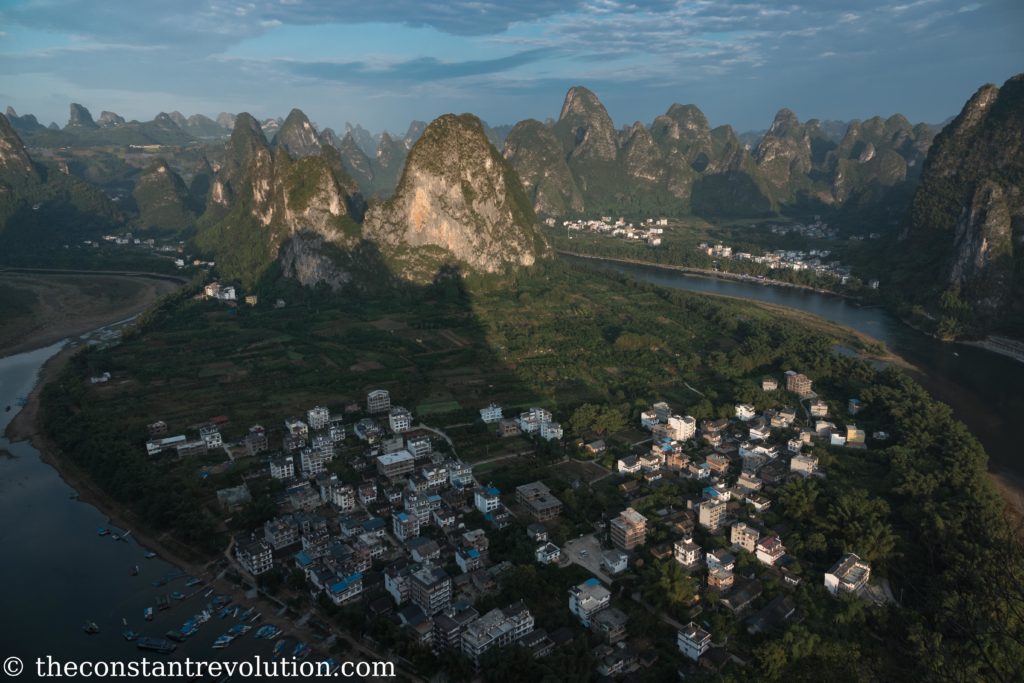
√ Damian mountain: to reach the summit of this mountain you have to cross the river from the main village to a part of the village that is on the other side. There are hotels on that side too in case you want to go for sunset or sunrise. The boats that take you across (5 Yuan) do not start soon enough in the morning and they finish too early in the evening. Although I didn’t go myself, sunrise must be pretty spectacular from there, the position is just perfect.
Attention: the trail marked on maps.me to reach the summit of Damian is wrong! It leads to an old trail that has been covered by bushes.
There are no maps and you have to find your way, but it isn’t very complicated without misleading information: basically, you cross the river on the east side of the mountain, which is right in front of you, but the starting point of the trail is on the north-west side. So you have to circle around the mountain in order to reach it.
Now, some sites say that in order to go to Damian you have to keep your left after crossing the river (so the mountain remains on your right side), pass close by a nunnery and continue on the right. Wrong! I mean, you can reach the starting point of the trail also from there, but it is much closer and faster if you keep the right (mountain remains on your left side) and semicircle on the left.
On this route there’s even a shortcut right after some houses, a small path on your left that leads you up and onto the trail. If you get it right, the whole operation from the crossing of the river doesn’t last more than 1h and a half.
Eventually, when you descend, you could go the other way and pass by the nunnery which is a nice detour, and a nicer walk.
√ Jinzhai mountain: also on the other side of the river, and a little bit further north-west, Jinzhai mountain is considered the best spot in the whole province to admire a sunset. Even when I went to Yangshuo I was suggested to go there for sunset. By looking at the map the position looks indeed great. Perhaps it is for this reason that it costs 60 Yuan to enter, the only place where you need to pay.
Out of principle I didn’t go. Well, also because I should come back by foot in the dark, and I wouldn’t know how to cross the river… anyways, from Xingping it takes about 1h and 40m to reach it by foot. It is possible to reach this point from elsewhere too, Yangshuo for example, by car or motorbike.
√ 20 Yuan view: the karst landscape is so well regarded in China that it ended up on the 20 Yuan note. So, there is a spot called 20 Yuan view where you get to see the exact same view of the note. Not so interesting really. But it is only 15 minutes by foot from the village. Cross the bridge, take the left, and keep going. You can’t miss it, there will be lots of people taking photos.
√ Nine Horse Fresco Hill: on the same route of the 20 Yuan view, but a couple hours farther on, there’s famous Nine Horse Fresco Hill. It’s a high vertical wall natural black and white shapes.
The legend goes that you can see nine horses in the shape and colours of the rocky wall. In the past, it was believed that if you saw at least seven horses you could participate to the competition to become a public official (these competitions were very prestigious and difficult in ancient China), and if you did see all nine horses you would win the competition. Still today, to see the horses is considered a good omen, so to speak. I haven’t seen any. Guess I am not going to win public competitions after all.
It is actually a regular tarmac road to reach the hill, not worth trekking at all. There are electric cars taking you there, or you can go by bicycle or motorbike. This would make it much faster. Then you have to cross the river to get to see the wall. There is a boat taking people back and forth. The other side of the river there is also nice for a bicycle tour.
√ Langshi trek: it’s possible to go by boat to Langshi, another village up north, and then trek back in 3-4 hours along the river. This is a nice way to go for a longer day out and enjoy the river in different ways.
√ Fishing village hike: in China it is often very easy to be off the beaten path. I mean, while everyone goes right, nobody thinks of going left. Or vice-versa. The trail that leads to the fishing village is marked on maps.me and relatively easy to follow, it is a splendid 1h and a half walk, it starts from Xingping, and, above all, there’s no one there. When I went I was completely on my own while five minutes earlier I was in the midst of all the tours going towards the river. Magic.
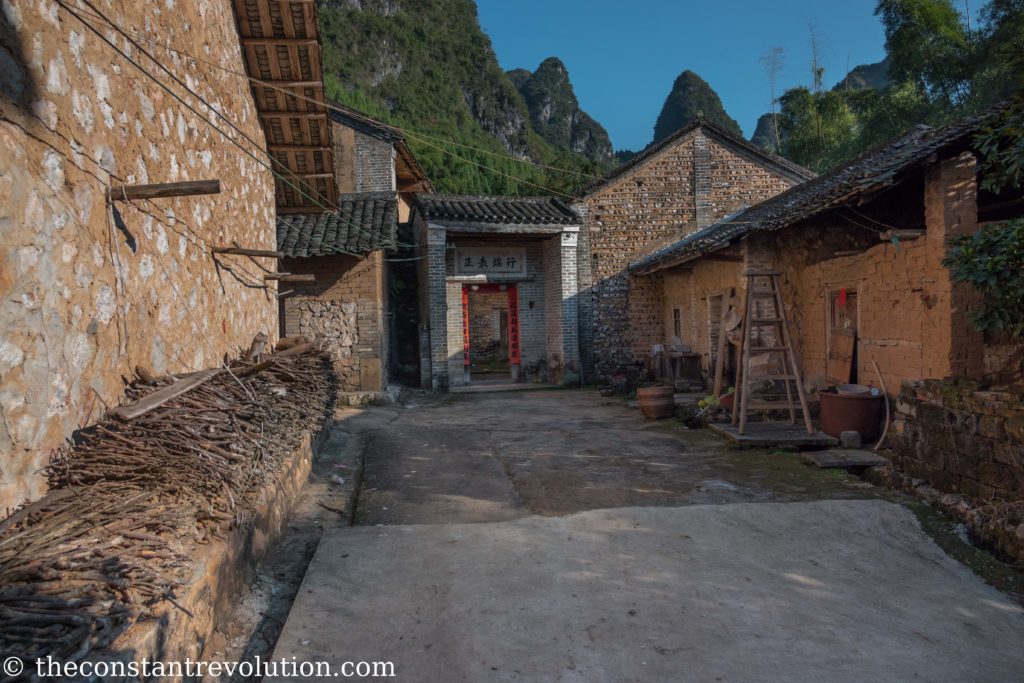
Do not expect however to find a folkloristic place. The fishing village is just a normal village with few houses and absolutely nothing else, not even a restaurant or a bar. I really enjoyed walking around the pomelo and mandarin fields, and then back along the river. You can either walk back to Xingping on the same trail, or several villagers will propose you a bamboo boat. A little extra cash, right?
√ Cormorant fishing act: a traditional way of fishing with cormorant is reenacted for the mere sum of 300 Yuan (about €40) upon request, for 1 to 4 people. Literally, these old dudes they dress up with traditional clothes, they have two cormorants tied up to a stick that they carry on their shoulders, and they take bamboo boats to pretend to go fishing at dusk, all for the pleasure of tourists taking photos of them or with them. The same dudes or their buddies wander around the port and the river also with cormorant all day long, trying to get a 10 Yuan note from you in exchange for a silly photo with the birds. I said it all.
Voilà, I believe there is quite enough to keep you busy in Xingping, in my opinion the best place to see karst landscapes in all tranquillity. The photos you’ll get on some of those viewpoints are truly spectacular. It’s also possible to go cycling or motorbiking in the nearby countryside, and in the right season to do some rafting.
FROM YANGSHUO
Unlike Xingping, Yangshuo is a proper city, and a very touristic one at that. It’s like a little Las Vegas overnight, with lots of lights, dance shows, international restaurants and coffee chains, well you got the picture, and if you didn’t, I’ll provide one:
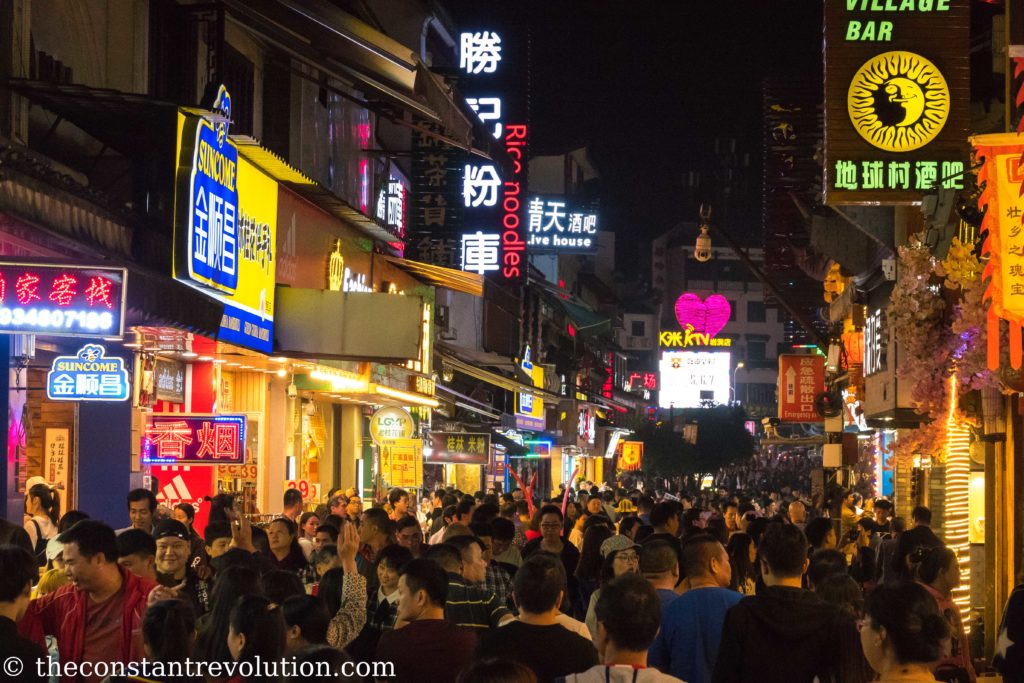
I do not enjoy this kind of place, too messy and too crowded for me, so I stayed only a couple of days.
However, there are some nice things to do:
√ Trek to TV tower mountain: TV tower mountain owns its name to, well, a TV tower placed at the top of it. However, it is a very scenic spot and very easy to reach. It is marked on maps.me. It takes about 40 minutes to climb and when you get to the top it seems the path is closed. There’s a fence to protect the TV tower, but some dudes working there will let you through if you hand over a 5 Yuan note 😉
This is true also for sunrise hikes, like the one I did, and I am sure glad I did it as it gifted me with the best colours of my time around these karst landscapes. See also the second photo of this post.
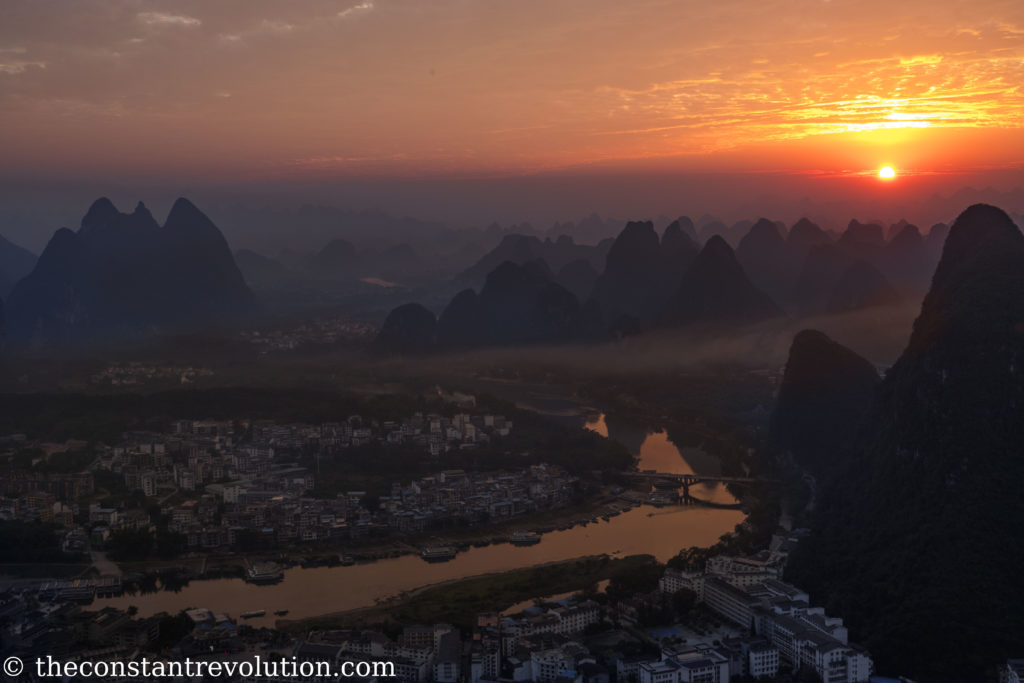
√ Watch the light show Impression Sanjie Liu: every night, 600 people give life to a magic light show on the waters of the Li River, in Yangshuo. Impression Sanjie Liu uses the surreal shape of karst mountains as a natural backdrop for what has become the biggest open-air theatre in the world. But is it worth to see? I tackled this question in a separate article.
√ Visit the Yulong river bridges: Yangshuo is the place where the Yulong river flows into the Li River, but if you follow its path backwards you’ll come across some beautiful countryside, villages, and some picturesque bridges, like the one of Jinlong and the one of Fu Li. It’s worth the tour, possibly by motorbike or bicycle to be free to visit the area at ease. Group tours are also organised by tour operators.
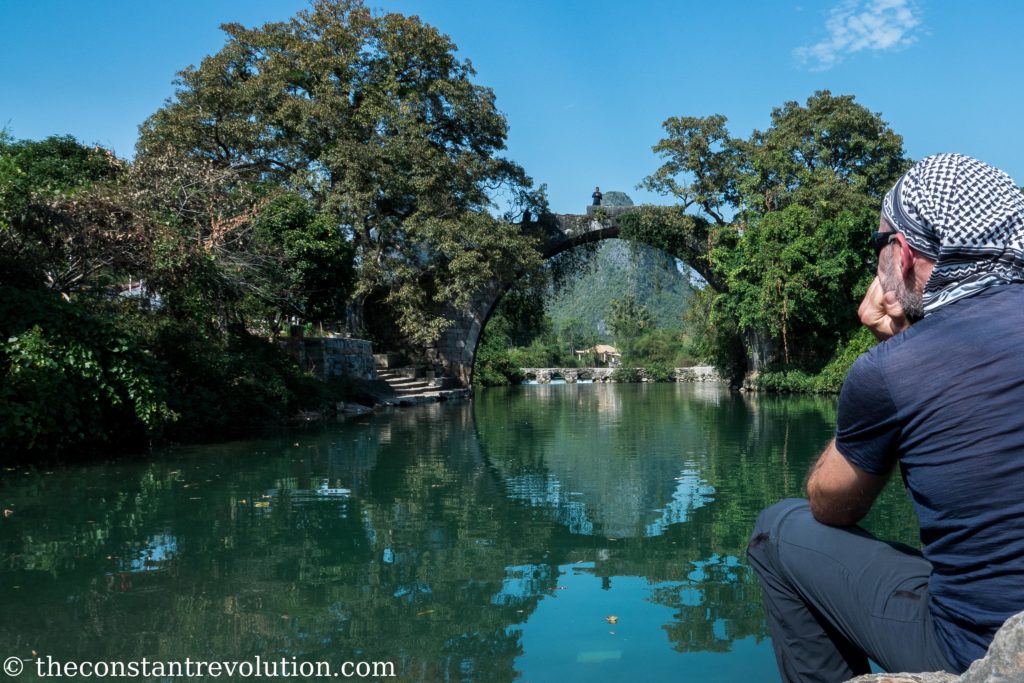
There are many other possible hikes around Yangshuo, but I have been there only two days, and opted to do something different.
FROM GUILIN
We come to what is probably the most famous spot of all when it comes to visiting the karst landscapes, and as a tourist destination in China for that matter. The name of Guilin is associated with these mountains and the scenery they offer, and the city is considered the pearl of China’s growing tourism. It is also a town with over 2000 years of history and cultural traditions. It has served as the political, economic and cultural centre of Guangxi since the Northern Song Dynasty (960-1127).
Indeed, the town has a nice vibe to it, there’s a lot of markets and street food, but without that party looking lights and modernity of Yangshuo. It makes for an enjoyable stay. From Elephant Trunk Hill to the Reed Flute Cave the city abounds with scenic spots and easy hikes. It is also possible to visit traditional villages, and easily organise to go and see Longsheng and Longji rice terrace fields. This is a spectacular detour from the karst formations, worth to do in the right season when the rice fields are green or yellow.
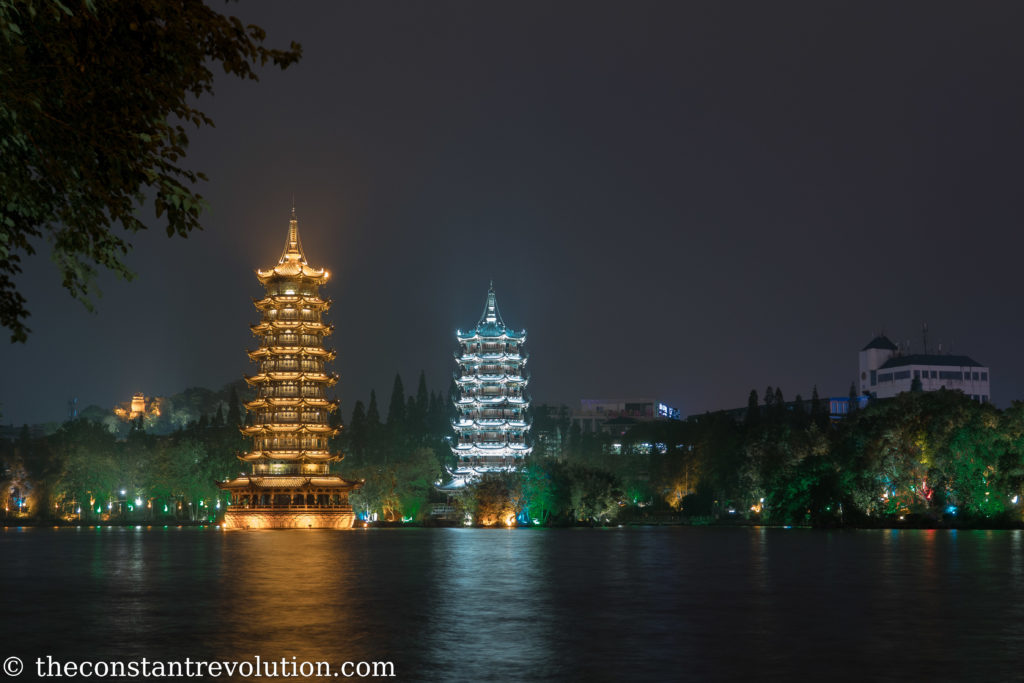
However, I haven’t done anything of all these nice things 🙂 I stayed three days in Guilin and for all that time it rained cats and dogs, with some short breaks only in the evenings. It was the type of rain that didn’t make you feel like going out. So all I have is a few photos taken overnight. This is also travelling. For Guilin’s mountains, it will be next time. In any case, I have been more than lucky in Xingping and Yangshuo.

Viva the transparency! There are affiliate links in this article. This means if you click on a link and end up buying (or booking) through those websites, I’ll get a small commission, at no extra cost to you. This helps me maintain the blog, and continue to provide (hopefully) useful travel information. I advertise only products I have tested and sites I use myself!
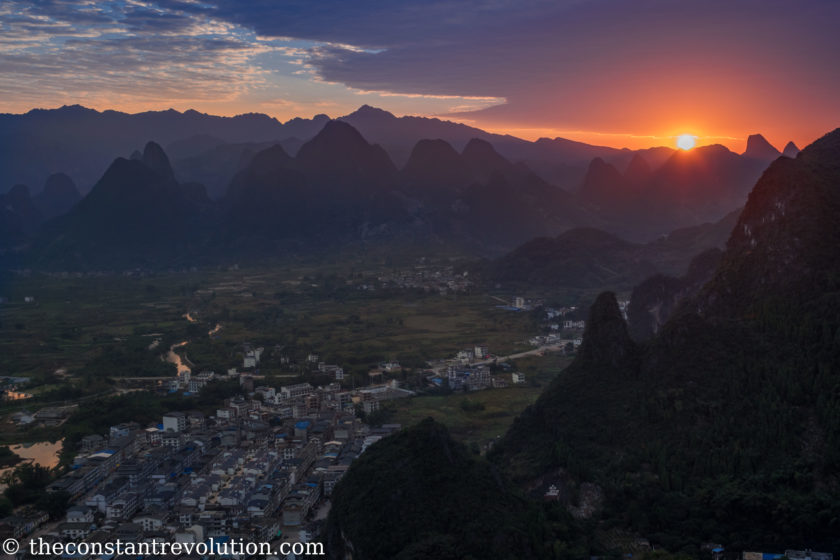

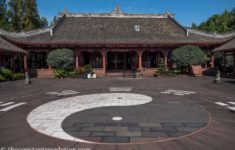
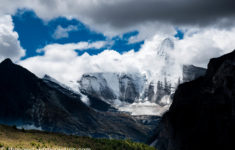
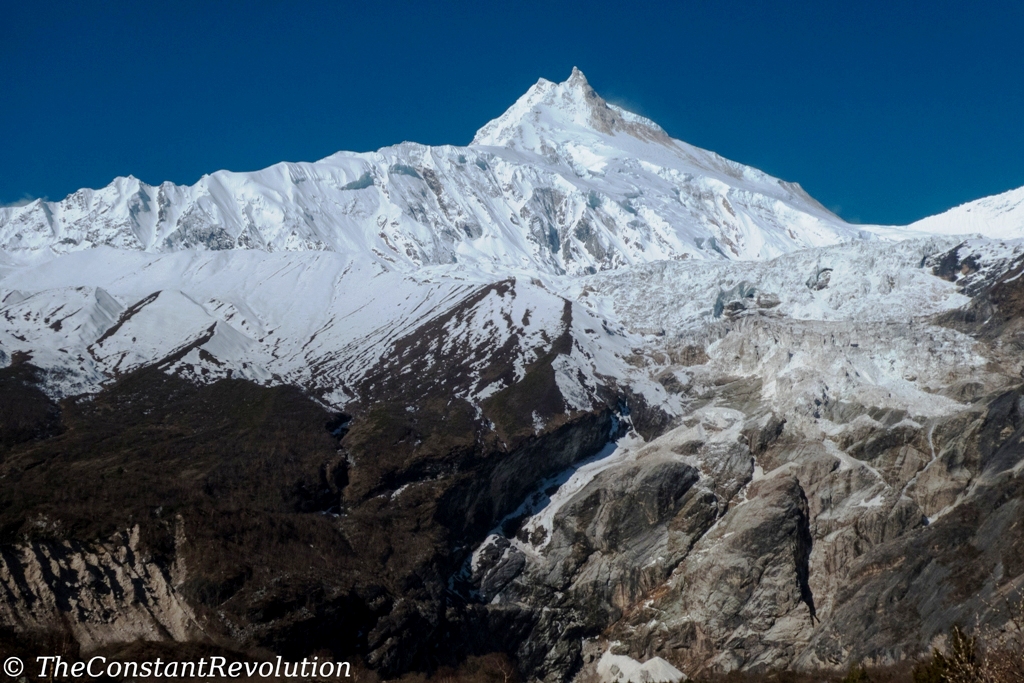

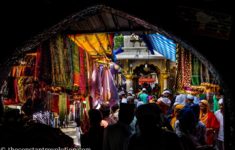
Great post Paolo .. very helpful. I’m just leaving the area. Late November is a quieter time and I took a mountain bike out to the villages.. where few Han Chinese tourists go.. great spot.. thank you so much for your informative blogs.. we met in Shangri la September..
Thanks Philip, glad you found it useful. 🙂 Happy travels!